The 52 Project, Week 30: All About Amherst
 Monday, March 14, 2011 at 8:29PM
Monday, March 14, 2011 at 8:29PM The large format adventures continue with more from my trip to Amherst, MA to visit my good and long-time friend Katie O'Neil. During the very brief visit, we had quite a few adventures, including but not limited to: (you can pm me for the entire scoop)
- Painting horses
- Bailing someone out of prison
- Visiting an insane asylum
- Meet Dr. Suess' nephew
- Losing cell phones and Polaroids deep in the woods
Fun times indeed. Now here are some scans:
 Preceding the Halloween party on the Lone Birch Farm, this is my failed attempt at a group shot. Note the lack of people. >__<
Preceding the Halloween party on the Lone Birch Farm, this is my failed attempt at a group shot. Note the lack of people. >__<
 This is Katie O'Neil. She loves horses, Ireland, good movies, and climbing trees. The first three are hard to photograph, so here she is.
This is Katie O'Neil. She loves horses, Ireland, good movies, and climbing trees. The first three are hard to photograph, so here she is.
 Ah urban decay, you photograph on large format so nicely. Well, at least when there's a contrasty scene; here, not so much. >__<
Ah urban decay, you photograph on large format so nicely. Well, at least when there's a contrasty scene; here, not so much. >__<
Just covering the bases again here, all of the above were VERY quick contact prints made onto Oriental RC VC paper, developed in generic Dektol replacement for 1:00 min. The prints were then scanned onto a trusty Epson V700 with some level tweaking in post.
Now a for this week's closing words.
Something Good: For my third overall batch of Pyrocat HD negatives, these guys all came out equally dense. Print times were all within 5 seconds of each other. When printing from a 20x24 equivalent height (for consistency's sake), that's actually pretty close.
Something Bad: These images as negatives were all equally over-processed. When over-processed negatives come out of a staining developer, the overall film base (usually clear) becomes stained/tanned itself. Not necessarily a bad thing, this side effect can be corrected by either reducing overall density in farmer's reducer or by printing longer...way longer. >__>
Something Learned: The more dense a Pyrocat stained negative becomes, the more filtration it will need to obtain proper contrast on VC papers. Remember, brownish-stain acts like a yellow SUPER-low contrast filter to VC paper, so this must be countered with yellow's compliment, purple light.
Next Week: Back to only one image, but a big one, with a great story and some great impact.

